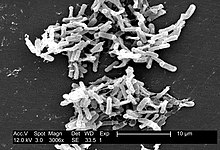C. difficile
| Clostridium difficile | |
|---|---|
 |
|
| C. difficile colonies on a blood agar plate | |
 |
|
| Micrograph of Clostridium difficile | |
| Scientific classification | |
| Kingdom: | Bacteria |
| Phylum: | Firmicutes |
| Class: | Clostridia |
| Order: | Clostridiales |
| Family: | Clostridiaceae |
| Genus: | Clostridium |
| Species: | C. difficile |
| Binomial name | |
|
Clostridium difficile Hall & O'Toole, 1935 |
|
| NCBI genome ID | 535? |
|---|---|
| Ploidy | haploid |
| Genome size | 4.3 Mb |
| Number of chromosomes | 1 |
| Year of completion | 2005 |
Clostridium difficile (etymology and pronunciation), also known as C. difficile, C. diff (/siː/ /dɪf/), or sometimes CDF/cdf, is a species of Gram-positive spore-forming bacteria.
Clostridia (members of the genus Clostridium) are anaerobic, motile bacteria, ubiquitous in nature, and especially prevalent in soil. Under the microscope, they appear as long, irregular (often drumstick- or spindle-shaped) cells with a bulge at their terminal ends. Under Gram staining, C. difficile cells are Gram-positive and show optimum growth on blood agar at human body temperatures in the absence of oxygen. When stressed, the bacteria produce spores that are able to tolerate extreme conditions that the active bacteria cannot tolerate.
C. difficile may become established in the human colon; it is present in 2–5% of the adult population. Sometimes antibiotic therapy for various infections has the adverse effect of disrupting the normal balance of the gut flora, in which case C. difficile may opportunistically dominate, causing Clostridium difficile infection.
...
Wikipedia
